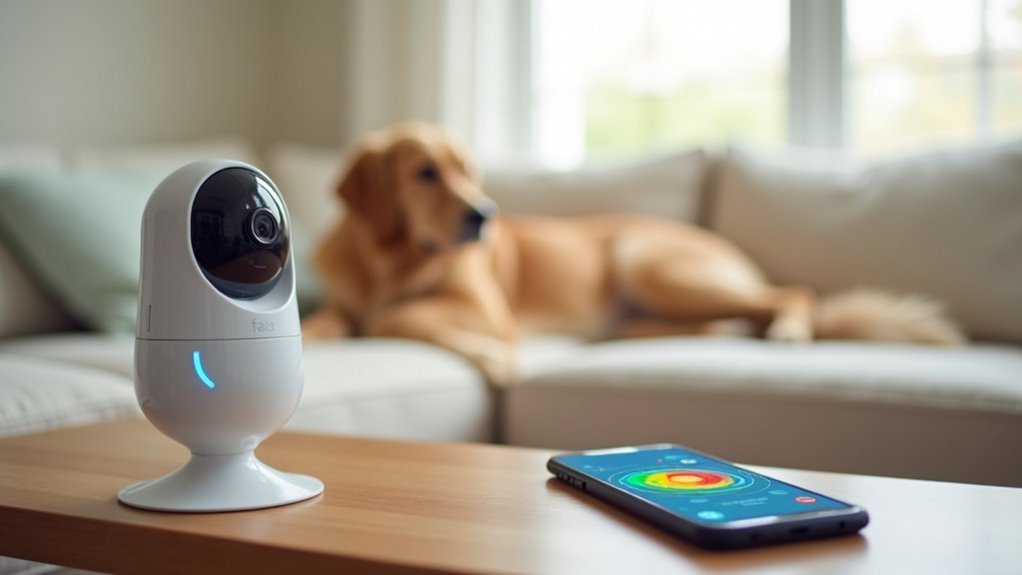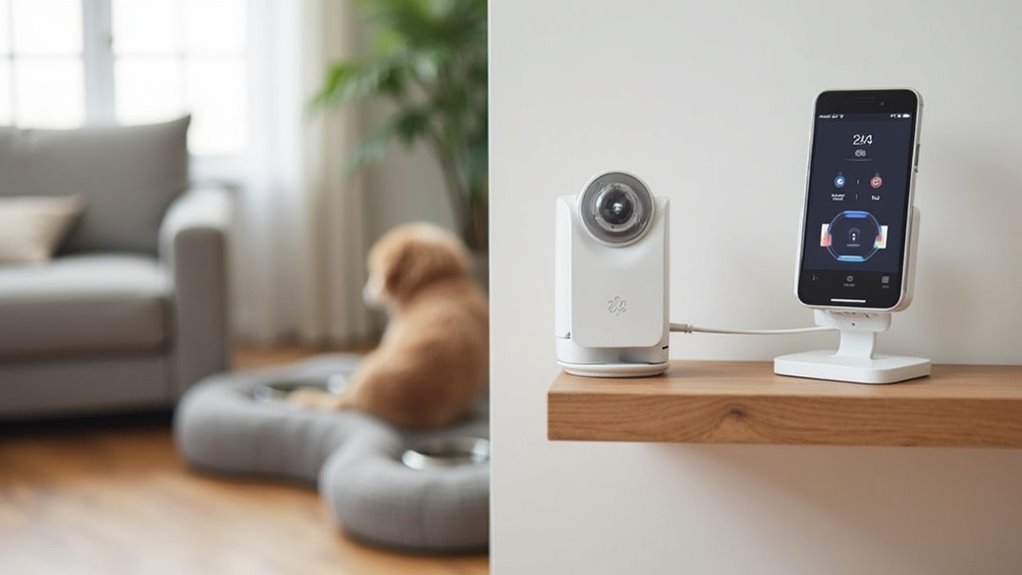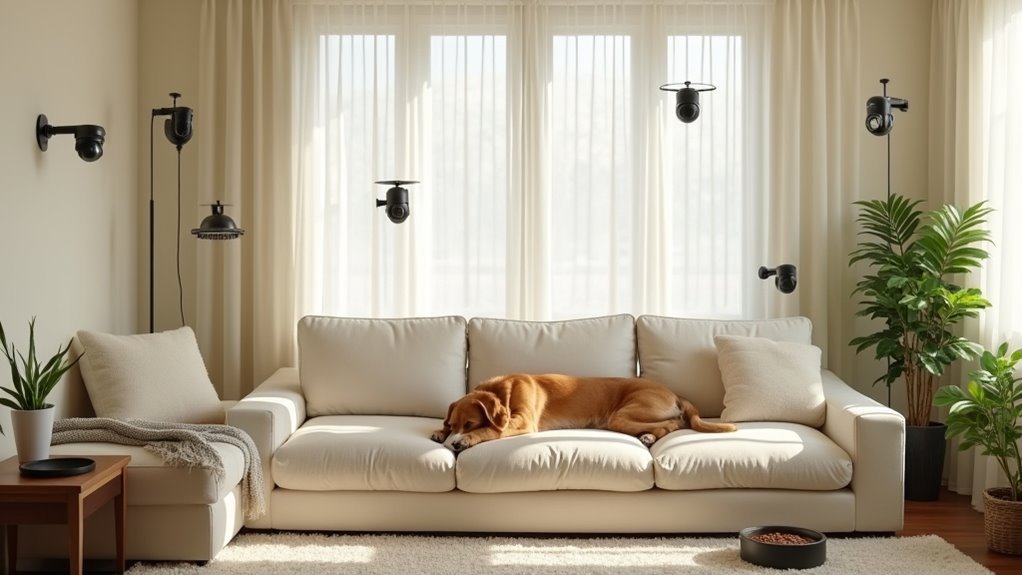You’ve invested in a pet camera, but improper setup can turn your monitoring solution into a frustrating tech nightmare. Whether you’re dealing with blurry footage, missed alerts, or connectivity issues, the difference between success and failure often comes down to a few critical decisions you’ll make during installation. These seven straightforward tips will transform your camera from an expensive paperweight into a reliable window into your pet’s world.
Choose the Right Camera Type for Your Pet’s Needs

When selecting a pet camera, you’ll need to match the device’s capabilities to your specific monitoring goals and your pet’s behavior patterns.
Match your pet camera’s features to your specific monitoring needs and your pet’s unique behavioral patterns.
Choosing the right model depends on your unique circumstances. Consider a treat-dispensing pet camera if you want active interaction with your smart pet while away—these devices keep pets engaged through remote rewards.
For extensive room coverage, opt for Pan-Tilt-Zoom cameras that adjust angles to follow your pet’s movements. Outdoor pets require weatherproof cameras designed for harsh conditions.
Standard pet cameras work perfectly for simple monitoring with live video and sound. Don’t overlook audio features—two-way communication helps soothe anxious pets and maintains your bond.
The best pet cams align with your lifestyle and your pet’s specific needs.
Find the Perfect Placement and Viewing Angle
After selecting your ideal pet camera, strategic placement becomes the foundation of effective monitoring.
Position your camera at your pet’s eye level to capture their activities closely and create an engaging viewing experience. Choose a location with clear sight lines to your pet’s favorite resting and playing areas, maximizing your wide angle coverage.
Avoid direct sunlight and excessive glare, which compromise video quality and cause overheating.
Test different angles using sticky tabs or temporary mounts before finalizing placement. This guarantees you’ll find the best view for smart motion detection capabilities.
Consider your Wi-Fi signal strength at the camera’s location. A strong connection is essential for uninterrupted live streaming and proper functionality of all camera features.
Test Your Wi-Fi Signal Strength and Coverage

Your camera’s physical placement means nothing without a robust Wi-Fi connection powering its features. You’ll need to test your Wi-Fi signal strength throughout your home to guarantee pet cameras maintain a reliable connection.
Download a Wi-Fi analyzer app and measure signal strength where you plan installing your camera. Aim for at least -70 dBm for ideal performance – weaker signals cause feed interruptions.
| Signal Strength | Performance | Recommended Action |
|---|---|---|
| -50 dBm or stronger | Excellent | Perfect for pet cameras |
| -60 dBm | Good | Suitable for most features |
| -70 dBm | Fair | Minimum acceptable level |
| -80 dBm or weaker | Poor | Install Wi-Fi extender |
Remember that distance from your router and obstacles like walls weaken signals. Position your router centrally, or invest in Wi-Fi extenders for better coverage.
Secure Your Camera With Proper Mounting
Once you’ve confirmed strong Wi-Fi coverage, you’ll need to physically secure your camera to prevent curious paws from turning your monitoring setup into a chew toy.
Proper mounting guarantees consistent monitoring while protecting your investment from pet interference.
Here’s how to establish a rock-solid setup:
- Choose mounting hardware – Use sticky tabs, brackets, or wall mounts appropriate for your camera’s weight and your wall type.
- Position at pet level – Mount the camera low enough to capture ideal angles while keeping it out of your pet’s reach.
- Select a stable surface – Use dedicated shelves or sturdy furniture to provide unwavering support for stationary cameras.
- Manage cables properly – Keep wires organized and hidden to prevent chewing accidents that could damage equipment or harm pets.
Configure Motion Detection and Alert Settings

With your camera securely mounted, you’ll need to fine-tune its motion detection capabilities to guarantee you’re notified when your pet needs attention without drowning in false alerts.
Access your camera’s settings through the mobile app to locate motion detection features. Adjust sensitivity levels based on your pet’s size and activity patterns. Most pet cams offer customizable detection zones, allowing you to focus monitoring on specific areas while excluding windows or doorways that might trigger false alerts from outside movement.
Set up motion alerts to receive real-time smartphone notifications when your pet moves around.
Consider scheduling detection for specific hours when you’re away from home. Regularly review your settings and update them as needed to optimize performance and reduce unnecessary notifications while ensuring you never miss important pet activities.
Set Up Two-Way Audio for Pet Communication
Two-way audio transforms your pet camera into a communication bridge, letting you comfort your furry friend when you’re away.
You’ll need to test your camera’s audio quality first, then fine-tune the microphone positioning to capture clear sound without interference.
Proper volume adjustments guarantee your voice reaches your pet at the right level while preventing feedback or distortion.
Audio Quality Testing
How can you guarantee your voice reaches your pet clearly while their sounds come through without distortion?
Testing your pet camera’s audio quality guarantees clear communication and prevents confusion or anxiety for your furry friend. Poor sound quality can disrupt the effectiveness of two-way communication, making it essential to verify ideal performance.
Follow these steps to test your camera’s audio quality:
- Make test calls using the camera’s built-in audio feature and adjust settings until sound becomes crisp and clear.
- Position the camera at pet level to enhance audio pickup and improve voice transmission.
- Test in a quiet environment to accurately assess microphone sensitivity without background interference.
- Regularly check audio settings after firmware updates or device relocations to maintain peak performance.
Microphone Positioning Tips
Strategic microphone placement makes the difference between frustrating static and crystal-clear conversations with your pet. Position your microphone close to where your pet spends most time to guarantee clear audio capture during communication sessions.
Test sensitivity settings to prevent distortion while maintaining quality two-way interactions. Place the microphone at your pet’s level to accurately capture their sounds and reactions.
| Position Factor | Recommendation | Benefit |
|---|---|---|
| Height | Pet level | Better sound capture |
| Distance | Close proximity | Clear audio quality |
| Direction | Toward pet area | Reduced background noise |
| Sensitivity | Tested settings | No distortion |
| Adjustment | Regular monitoring | ideal communication |
Consider directional microphones to minimize background noise, guaranteeing your voice remains prominent. Regularly adjust positioning based on your pet’s behavioral patterns for effective communication.
Volume Level Adjustments
Why does your pet seem startled or ignore you during camera conversations? Volume level adjustments are essential for establishing clear communication through your smart home pet camera’s two-way audio feature.
Here’s how to optimize your audio settings:
- Test and observe – Make calls to your camera while watching your pet’s reaction to find the perfect volume that keeps them comfortable and responsive.
- Adjust microphone sensitivity – Fine-tune settings to reduce background noise and guarantee your voice comes through clearly without distortion.
- Position speakers properly – Confirm the camera’s audio components are correctly placed for maximum sound quality in both directions.
- Monitor regularly – Check volume levels frequently and readjust if you notice behavioral changes during interactions.
Download and Test Your Mobile App Connection
Start by downloading your pet camera’s mobile app from the App Store or Google Play Store, making sure it’s compatible with your device.
Create an account or log in with existing credentials to link the app with your camera for seamless access.
Test your connection immediately by viewing the live feed while confirming your camera’s powered on and connected to Wi-Fi.
App Download Process
The foundation of successful pet monitoring lies in properly downloading and configuring your camera’s mobile application.
Your mobile phone becomes the central hub for monitoring your furry companion, so getting this setup right is essential for seamless operation.
Here’s your step-by-step app download process:
- Locate your camera’s specific app in the App Store or Google Play Store using your pet camera’s exact model number.
- Download and install the application directly to your mobile phone, ensuring you have adequate storage space.
- Create your account or log in with existing credentials to access all camera features and settings.
- Test the live video connection immediately after setup to verify both video quality and audio functionality work properly.
Connection Testing Methods
Once you’ve successfully downloaded your pet camera’s mobile app, establishing a reliable connection becomes your next critical step.
Connect your smartphone to the same Wi-Fi network as your pet camera to guarantee seamless streaming. Open the app and follow the setup instructions, which typically involve creating an account and pairing your camera using a unique code or QR scan.
Perform a thorough connection test by accessing the live feed within the app. Check that both video and audio quality meet your monitoring expectations.
If you’re experiencing connectivity issues, examine your Wi-Fi signal strength and consider repositioning either your camera or router. A strong, stable connection assures you’ll receive clear footage and real-time alerts when monitoring your pet remotely.
Frequently Asked Questions
What Is the Easiest Pet Camera to Set Up?
You’ll find Furbo and Petcube cameras easiest to set up since they feature plug-and-play designs with step-by-step mobile apps. Wyze Cam’s also simple with quick mounting options and QR code scanning for instant device pairing.
Where Is the Best Place to Put a Pet Camera?
You’ll want to position your pet camera at your pet’s eye level in a corner with strong Wi-Fi signal. Avoid windows due to glare and secure it properly so your curious pet can’t knock it over.
How Can I Watch My Dog at Home From Work?
You’ll need to set up a pet camera that streams live video to your smartphone. Choose one with strong Wi-Fi, two-way audio, and treat-dispensing features for ideal monitoring and interaction.
What Is the Best Camera for Leaving Dogs at Home?
You’ll want the Furbo for treat-dispensing and two-way audio, or consider the Petcube Bites 2 for HD video with night vision. Both offer motion alerts and reliable connectivity for monitoring your dog remotely.





Leave a Reply